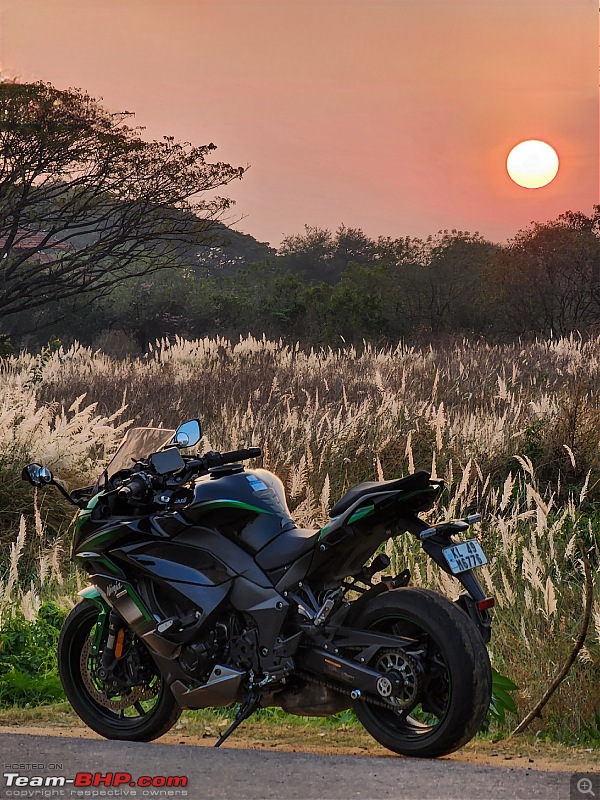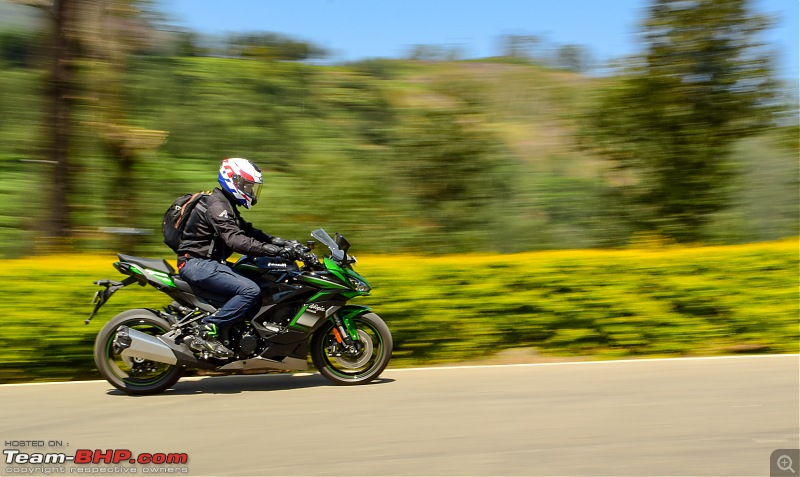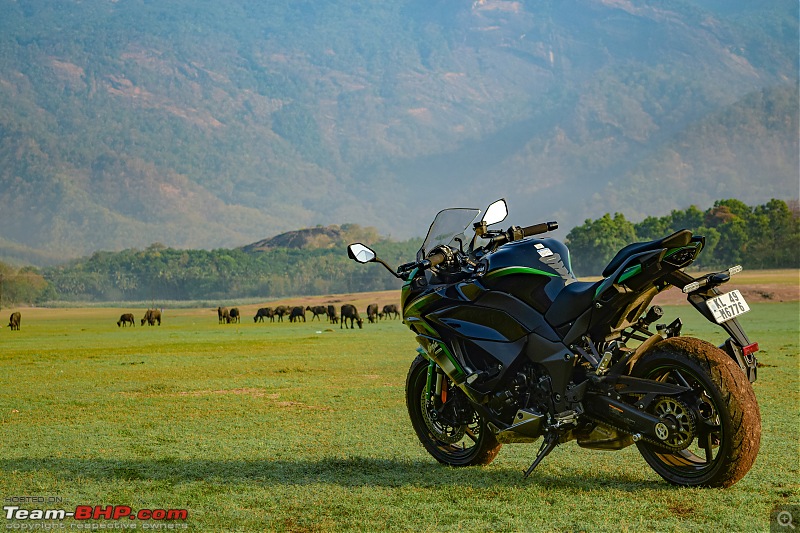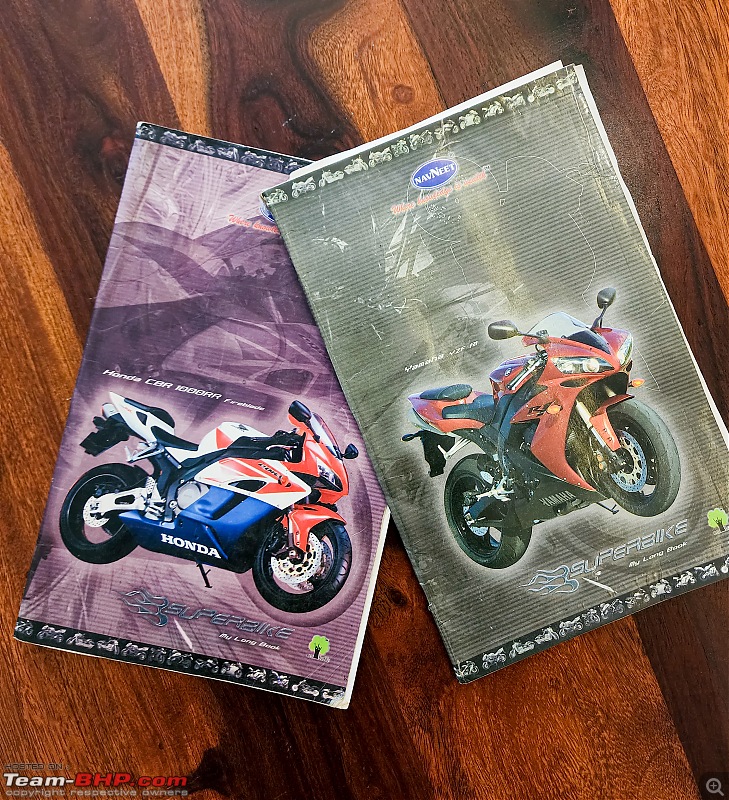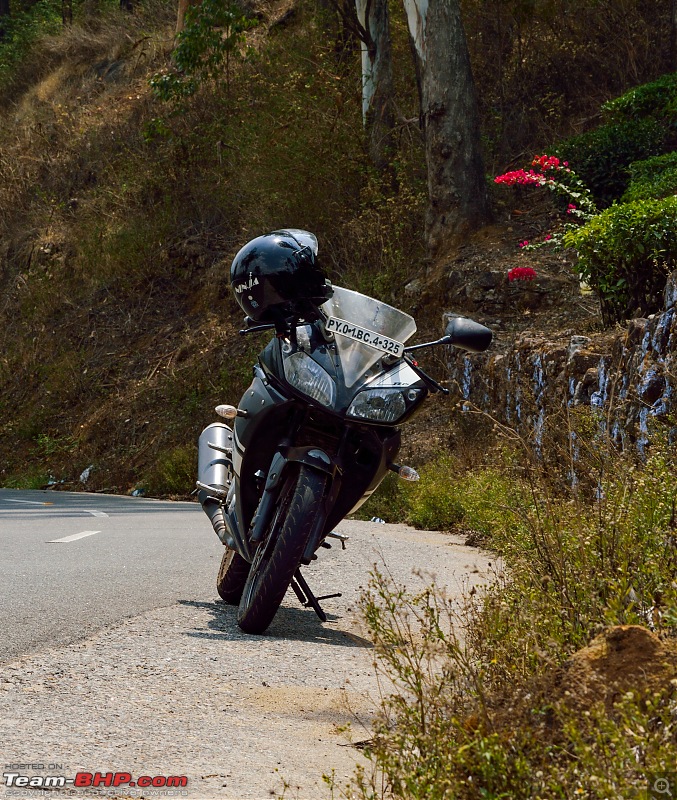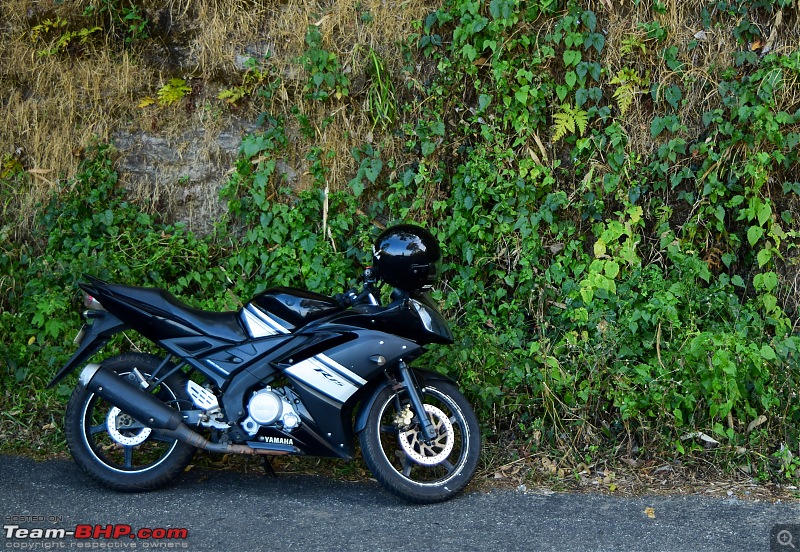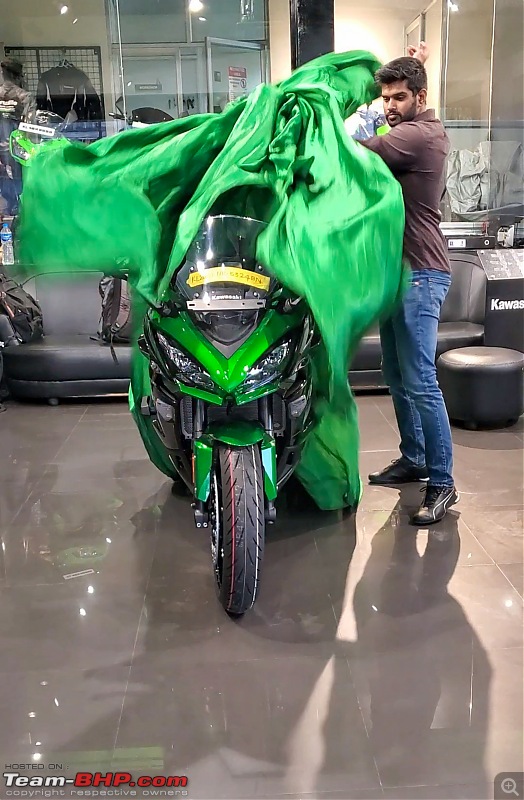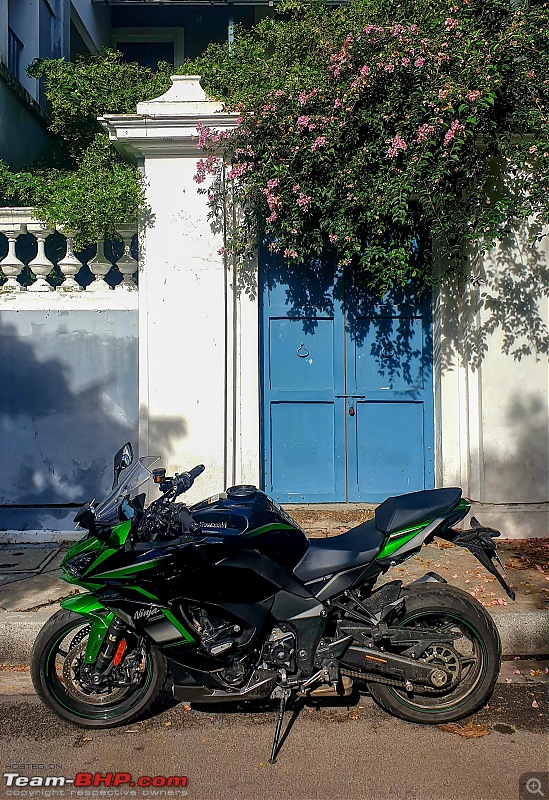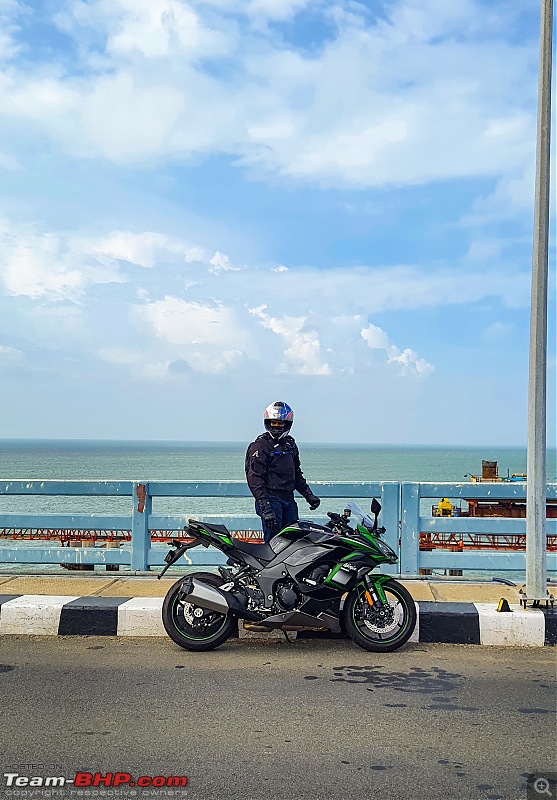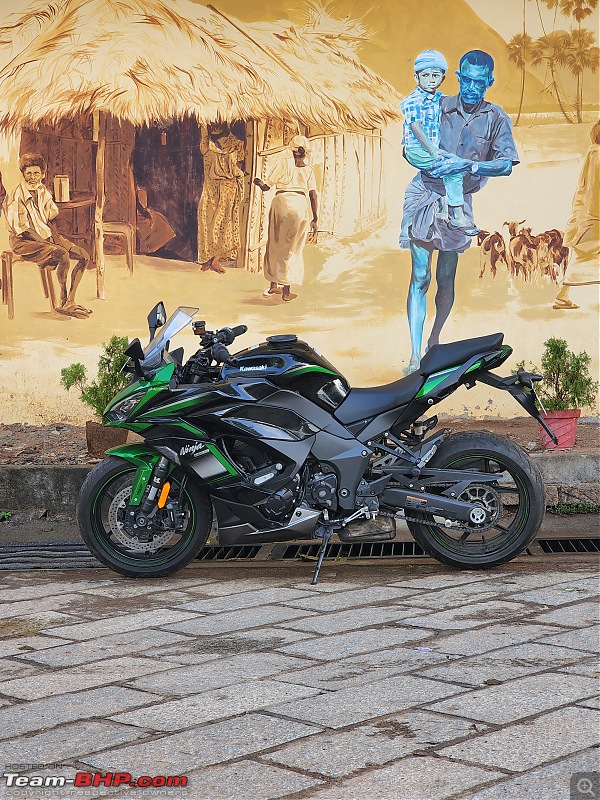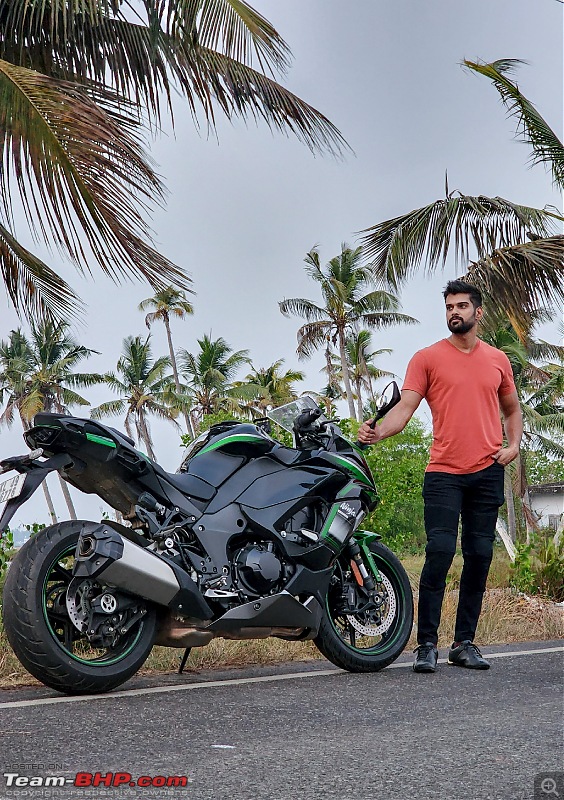The Journey
The specs and all the other details about buying and maintaining a Ninja 1000 are beautifully covered in
bhpian KarthikK’s thread. So I will only be covering the issues and the observations concerning my particular bike.
The Ninja 1000SX has a few key differences from the older Ninja 1000, even though much of the bike is the same. Some of the notable differences:
- Single exhaust vs twin exhausts, and the 1000SX is 4kg lighter.
- TFT console.
- Seat height - 835mm for the 1000SX vs 815mm for the 1000.
- Fairing design.
- LED indicators.
- New visor with more adjustments.
- Rake angle reduced by 0.5 degrees.
- Up and down quick shifter.
- Cruise control.
- Switch gear.
- Brake levers are different. More on this later.
- Connectors for accessory power outlets and heated grips use Sumitomo HM090 connectors, while the older Ninja used bullet connectors.
Favourite angle of the bike.

Least favourite angle of the bike. The exhaust is not good looking.
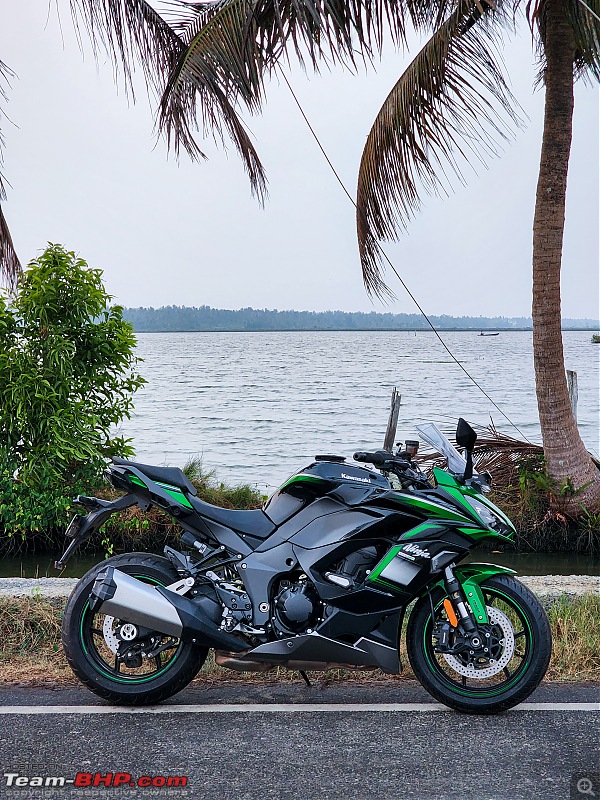
Front visor has a new design. This picture was taken when the odo was around 12500 kms. Note the almost bald stock front tyre.
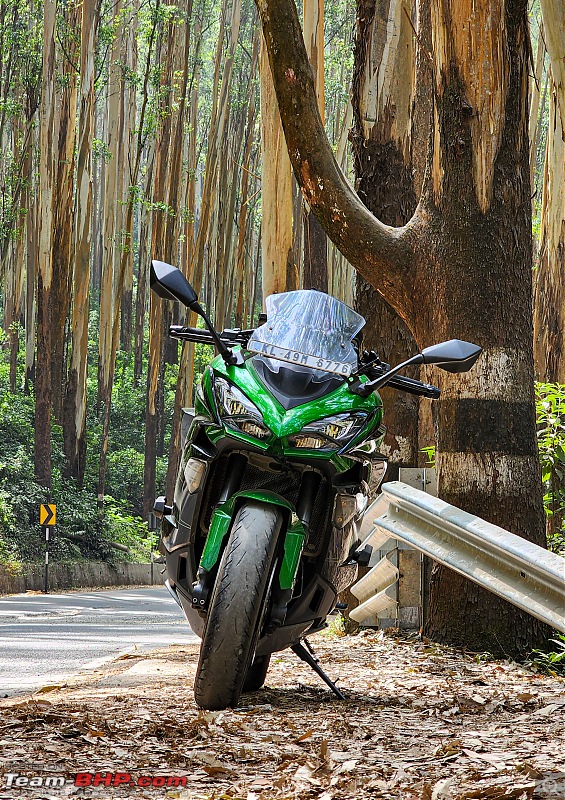
Quick shifter.

The new console is shared with many other Kawasaki models, from Ninja 650 to ZH2. It has two different UIs, namely Mode 1 and Mode 2, each of which has a light and a dark mode. Mode 2 is more track oriented with lean angle, throttle and brake modulation displayed prominently.
Mode 1 on light mode.

Mode 1 on dark mode.
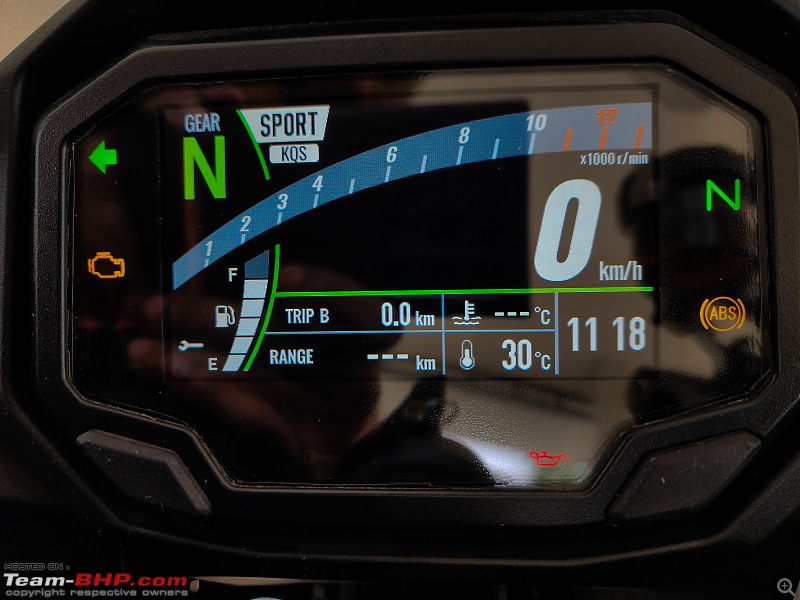
Mode 2 on light mode.

Mode 2 on dark mode.

The switch gear is different from the older Ninja 1000, and is also shared with multiple Kawasaki models.
Cruise and menu buttons.
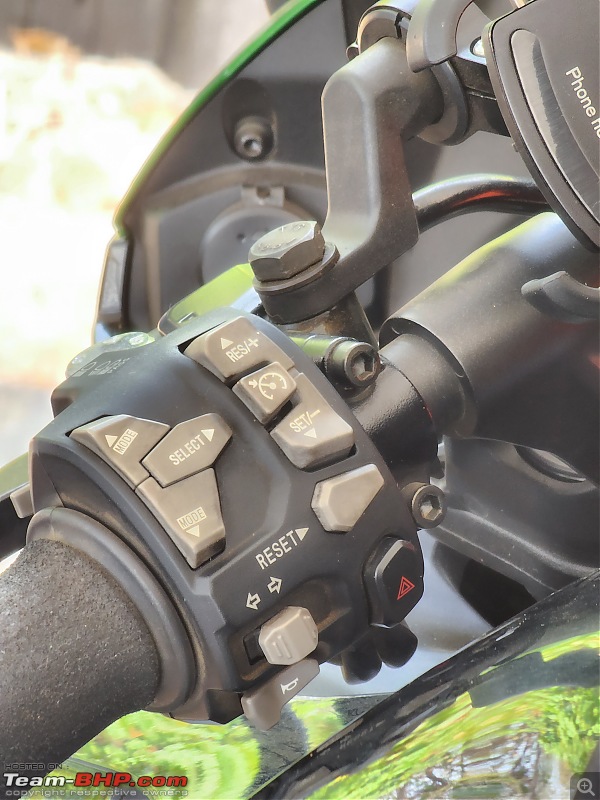
Flasher and high beam on the same switch.

Engine start and engine kill on the same switch.
 Likes
Likes- Tractability of the motor. Power is available all through the rev range. The bike can pick up cleanly from as low as 30 km/h in 6th gear. Overtakes, especially in 2 lane Kerala roads, are much easier and safer.
- Comfort. Supremely comfortable ergonomics for someone of my size and build. Very composed suspension. Both the rider and pillion seats are wide and comfortable.
- Braking was a revelation for someone not used to a premium motorcycle. Small tap on the lever can shed a lot of speed. Brake calipers by are made by Tokico, and master cylinder and levers by Nissin.
- Headlights are car like in illumination. All lights, including indicators, are LEDs.
- Fuel consumption of 20kmpl is the norm with my style of riding, and anything less is an exception. With a 19 litre fuel tank, that's a range of almost 400 kms.
- Reasonably good handler. Quick change of direction is not cumbersome at all, given how heavy it is.
- Quick shifter - I use it all the time. It is one of those things that I didn't know I wanted, until I got one.
Dislikes- Weight – Coming from the R15 v1 which has a dry weight of 120kg to something that weighs over 230 kg, the thought of the weight was more challenging for me than the real weight was. Once I started riding the bike, realised that the weight was easily manageable and most of the issues were in my head. But weight can still be felt while moving it in the parking lot and while taking tight U turns.
- Seat height of 835mm - I am 5'9" tall with a 32” inseam and I am able to flat foot when the surface is flat. But when there is a slope or banking on one side, flat footing on both sides become impossible. Ninja 1000 has a seat height of 815mm, which is 20mm lower than the 1000SX.
- Pathetic stock horn. Even my Vespa has a better stock horn.
- Hit or miss service experience.
- Ground clearance of just 135 mm. The cat-con scrapes most of the older speed breakers.
- Saree guard - Looks ridiculous, but an improvement in design from the atrocious saree guard of the older Ninja 1000. It was removed within a week of delivery.
Ninja 1000SX saree guard is ugly. (pic from the internet)
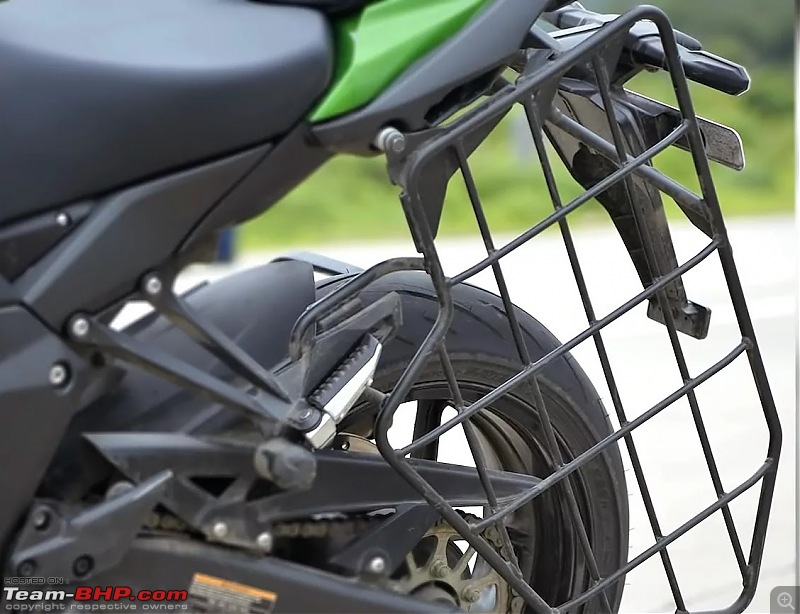
The older Ninja 1000 saree guard, the most horrible looking saree guard ever. 1000SX definitely has an improved design over this. (pic from the internet)
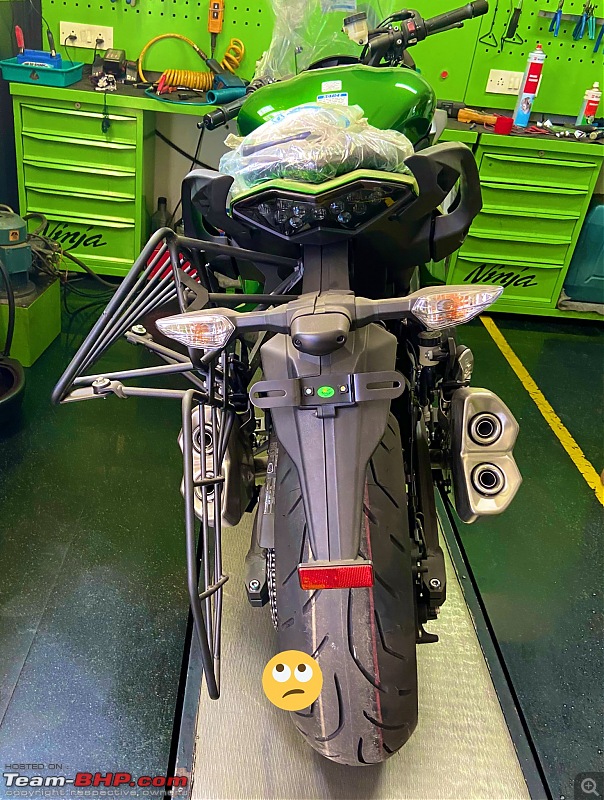 Issues faced
Issues faced- Stalling issue - A month after the first service (1000 kms service), the bike started having a stalling issue. The issue occured when the throttle is released on the move. The engine rpm falls and the engine dies. Contacted the service center and they mentioned some issue with the throttle body, and said a recall was forthcoming. Got a call from them the next week and took it for the recall. Post that, the issue never occurred.
- Brake lever incompatibility - While returning after the recall, I had to take a U turn near the service center. The road was sloping to the right at the U turn and there was also some gravel on the slope. While standing still for the traffic to clear, I lost footing due to gravel, with the slope contributing to it. There was a divider wall on my right and I leaned the bike on to it. The front brake lever hit the wall and broke off. I called the service advisor, who promptly came and took the bike to the service center. The brake lever was changed within 5 mins. There was no other damage, no scratches etc. Everything was going well on the braking front after that, or so I thought. After 6 months, took the bike for the 2nd service. While inspecting the bike, service advisor noticed that the brake lights are always at max brightness (as if the lever is pressed all the time). They diagnosed the issue to the brake lever. Earlier, while replacing the lever, the SA used the Ninja 1000 lever instead of the 1000SX one. The 1000SX has a cruise control cut off switch and the brake light switch, both controlled using the lever. So the brake lever was pressing on the brake light switch all the time, even though the braking itself was perfectly fine. I did not notice it because I never used the cruise control. They didn’t have the brake lever in stock, but promised to mail me the same once it’s available. It’s been more than a year, and multiple visits and calls, and they have not made it available to me yet. Decided to order the same from cmsnl.com, even though it’s priced slightly higher there.
- Stock horn died after around a year. Even though the bike was still under warranty, I didn’t want it to be replaced with the same OEM horn. So ordered Bosch symphony and did a DIY installation as explained in bhpian dkaile’s thread.
Mods/Accessories- Radiator guard - from the service center. Brand unknown,probably Chinese.
- OEM Low seat - After the lever broke off, I became paranoid about scenarios where I won’t be able to flat foot on both sides. This led me to look for low seat options. Modifying the stock seat by removing the padding was considered, but dropped the idea due to concerns about loss of comfort. Checked the showroom about the OEM low seat option and they quoted a price of Rs. 35000. Googled a bit and found out about cmsnl.com. Ordered from them to Dubai for about Rs.19000 and a friend carried it here. The low seat lowered the seat height by 28mm, from 835mm to 807mm.
- Tanklock tank bag and tank ring from Givi. While researching for a tank bag, found out that the 1000SX has a different fuel tank cap compared to the 1000. As a result, the compatible Givi tank ring is also different. The compatible tank ring for the older 1000 is the BF 04 and for the 1000SX is the BF 29. The bag chosen was ST603B, with a very practical 15 litre capacity.
- Horn upgrade to Bosch symphony.
- Dual USB charging socket. As mentioned in bhpian dkaile’s thread, ordered bullet connectors and a charging socket from ebay. Jonathan Long’s YouTube video about charging socket installation also came in handy. Once all the ordered items were here, I proceeded to remove the fairing and tried finding the bullet connectors, which was nowhere to be seen. Google was of no help as there were very few 1000SX mods/accessories threads in the internet then. A look into the owner’s manual showed a new type of proprietary-ish connectors. I later found out that these were called Sumitomo HM090. Since I couldn’t find a compatible connector to buy online, decided to strip the connector and connected the wire directly to the charging socket.
- Phone mount – Wanted a fork stem mount. But the 1000 and 1000SX has a 12mm hex hole fork stem bolt. The usual fork stem mounts can be used, but only after some jugaad, which I didn’t want to do. A compatible hex hole mount was difficult to come by for a reasonable price, so decided to go for a cheaper Bobo phone holder. I use my secondary phone on it, so no worries about the vibrations affecting the camera.
- PPF done at Aucust, Kochi.
OEM frame slider.
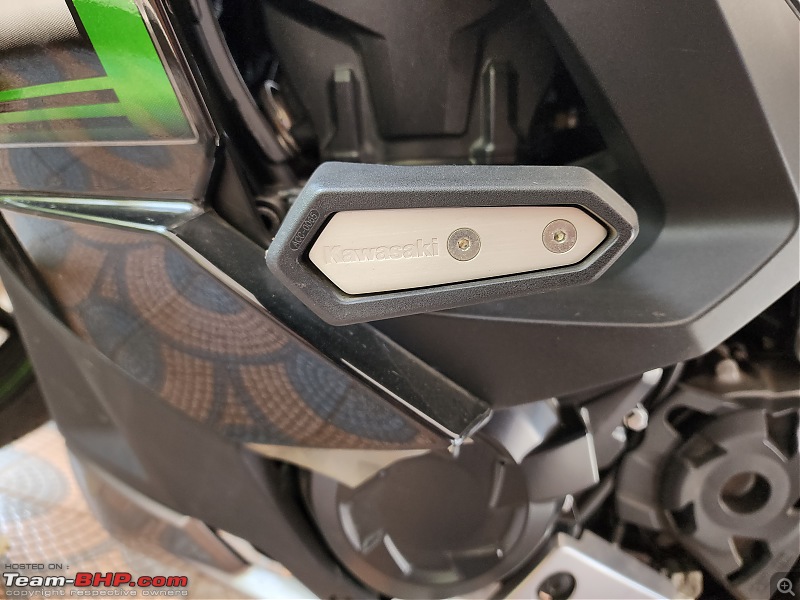
OEM low seat has a different contour than the stock seat. The front part of the low seat has much lesser cushion than the stock seat. The rear part has similar cushioning.

Low seat vs Stock seat. (pic from the internet)
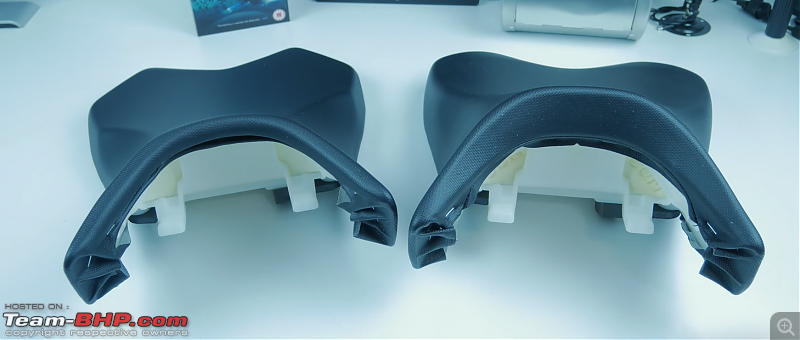
Fuel tank cap.
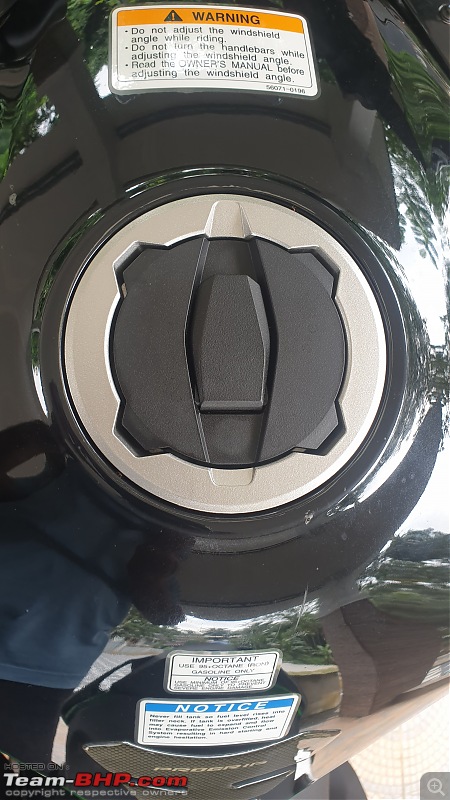
With Givi BF29 tank ring installed.

HM090 connector. All three accessory sockets in the Ninja 1000SX (2 in the front and 1 under the seat) are these. Forgot to take a picture while installing. (pic from the internet)

Charging port with the engine off.

And on, displaying the voltage.

With cap open.

Bosch symphony installed at the new location.
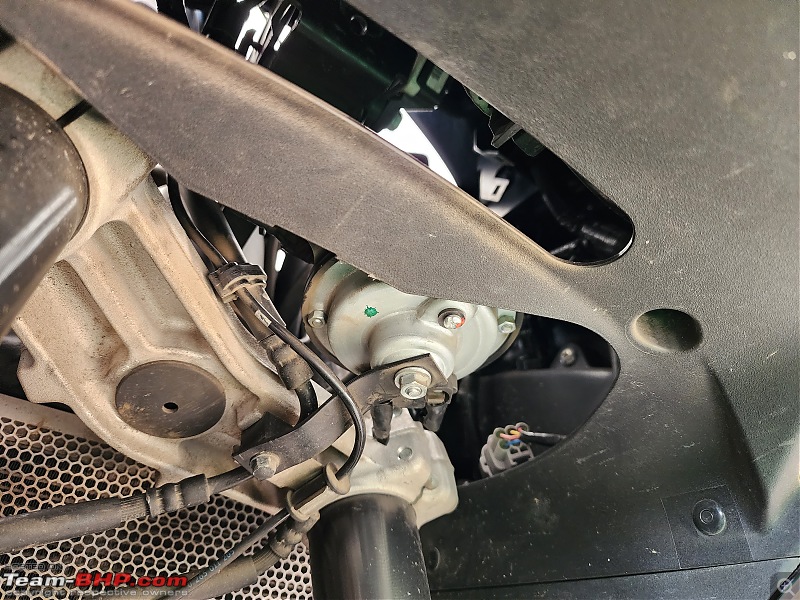
Kriega fork seal cover.

Fork stem bolt with hex hole. The usual screw type phone mounts (RAM mount, Quadlock etc.) can be installed after some jugaad.

The compatible 12mm hexagonal mount. It is ridiculously priced.

Bobo phone holder. Relatively cheap, but very durable.

It is mounted on the left accessory mirror hole using an extension, to make it as close to the center as possible.
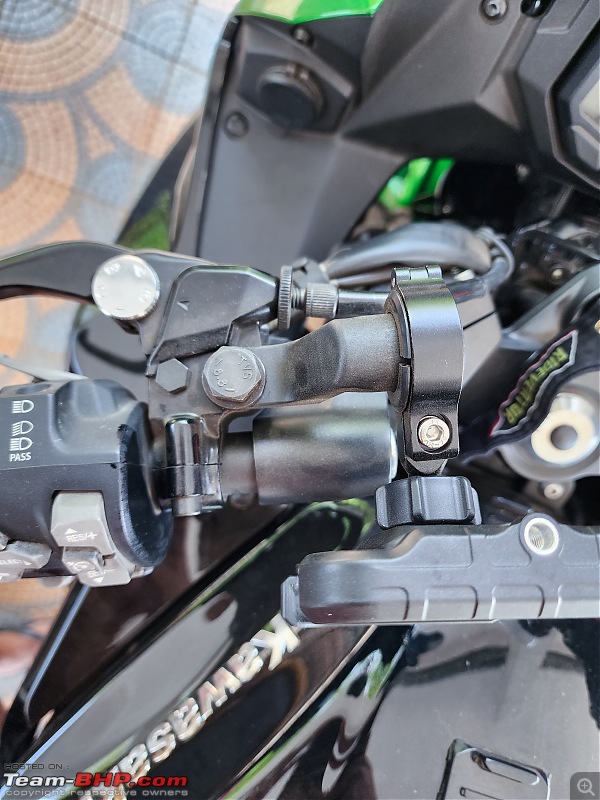
The stock Bridgestone battlax lasted for around 13000 kms. Chose Vredestein Centauro ST from The Tyre Guys, Kochi. Paid Rs. 25600 for a set, including wheel balancing and installation.
The Vredesteins. Only covered around 500kms in this. Grip feels good as of now.
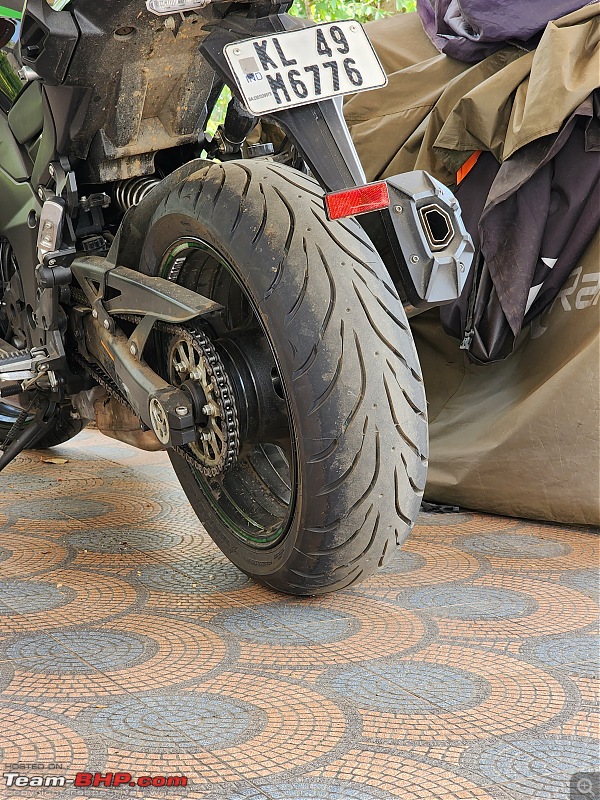
The Bridgestones were a little more attractive to look at, compared to this.
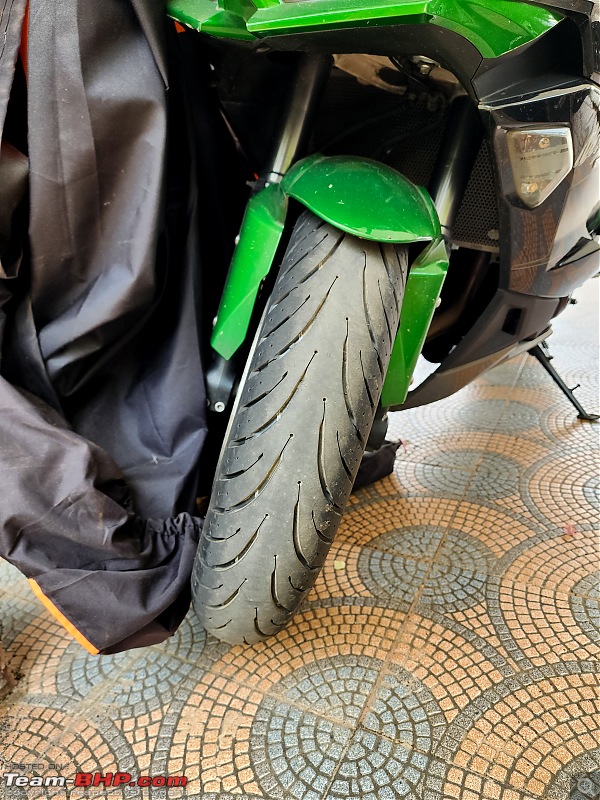


 (26)
Thanks
(26)
Thanks
 (18)
Thanks
(18)
Thanks
 (20)
Thanks
(20)
Thanks
 (22)
Thanks
(22)
Thanks
 (44)
Thanks
(44)
Thanks

 (3)
Thanks
(3)
Thanks
 (3)
Thanks
(3)
Thanks
 (3)
Thanks
(3)
Thanks
 (2)
Thanks
(2)
Thanks
 (4)
Thanks
(4)
Thanks
 (2)
Thanks
(2)
Thanks
 (3)
Thanks
(3)
Thanks
 (2)
Thanks
(2)
Thanks
 (3)
Thanks
(3)
Thanks
 (4)
Thanks
(4)
Thanks



